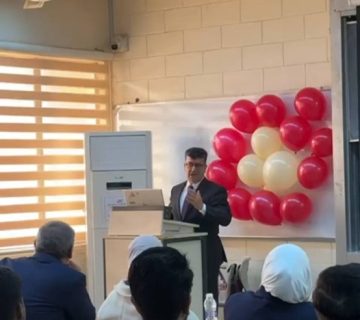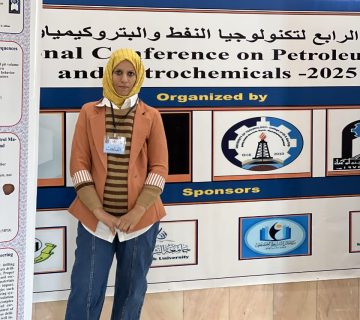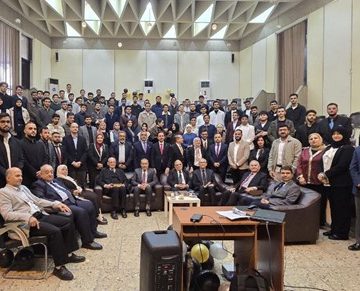Environmental Engineering Department at the College of Engineering, University of Baghdad, held PhD dissertation examination on Wednesday 16\7\2023 titled:
“Synthesis of immobilized bimetallic composite for remediation of groundwater contaminated with copper ions and ciprofloxacin”
By the student Noor Alaa Abdulhussein and supervised by Prof. Dr. Ziad Tarik Abd Ali. The examination committee consisted of Prof. Dr. Ayad Abdulhamza Faisal as Chairman, and the membership of Prof. Dr. Firas Hashim Kamar, Prof. Dr. Khalid Khazal Hummadi, Prof. Dr. Mohammed Sadiq Salman, and Assist. Prof. Dr. Hussein Jabbar Kadhum. After conducting the public discussion and listening to the student’s defense, the dissertation was accepted. It was summarized as follows:
In this study, the quartz sand (QS) was supported by the nanoparticles (Fe/Pb) that were made using an in-situ green synthesis technique using pomegranate peel extract as an antioxidant instead of chemical material that can harm the environment to produce a QS-Fe/Pb nanocomposite, it was utilized as a reactive material in permeable reactive barrier (PRB) for remediating the contaminated groundwater with ciprofloxacin (CIP) & copper (Cu(II)) in batch and continuous modes. Several parameters influencing the removal process in batch and continuous modes were studied to obtain the best conditions that achieve the highest removal percent (99%), and to evaluate the activity of the prepared nanocomposite as a reactive bed. The sorption of CIP and Cu(II) was investigated in a batch process at various: pH ranges (for CIP pH = 2–12 & for Cu(II) pH = 2–7), initial contaminant concentration (Co, 50-250 mg/L), nanocomposite dosage (0.05-1 g/50 mL), agitation speed (0-250 rpm), time ( 0 – 180 min). The best values of these parameters that provided removal percent of 99% were [pH=7, Co = 50 mg/L, time= 70 min, agitation speed= 200 rpm, and (QS-Fe/Pb) dosage= 0.5 g/50mL] for CIP & [pH =6, Co = 50 mg/L, time=120 min, agitation speed=200 rpm, and (QS-Fe/Pb) dosage= 0.7 g/50 mL] for Cu(II). Two isotherm models (Freundlich and Langmuir), and three kinetic models (intraparticle diffusion, pseudo first and second-order) were utilized. The results indicated that Freundlich and the pseudo-second-order models show a better fit for the batch experimental data with adsorption capacity of 15 and 9.8 mg/g for CIP & Cu(II), respectively. The characterization of the prepared nanocomposite was determined using many analyses such as X-ray Diffraction (XRD), Fourier Transform Infrared (FTIR) Spectroscopy, surface area measurements, Scanning Electron Microscope (SEM), Energy-Dispersive X-ray (EDX), and Transmission Electron Microscopy (TEM).The results of these analyses confirmed that the sand surface was covered with nanoparticles (Fe/Pb) successfully, which lead to an increase in its functionality for the removal of contaminants due to increased surface area.
The continuous mode was done through the study of many factors such as initial contaminant concentrations, solution flow rate, bed height, and hydraulic conductivity. The QS-Fe/Pb reactive medium was shown to have a substantial role in slowing down the migration of the CIP and the Cu (II) plume. This slowing down was more significant for the CIP than it was for the Cu (II). In addition, the continuous experimental data were fitted with five models of breakthrough curves (Thomas-BDST, Bohart–Adams, Belter-Cussler-Hu, Yan, and Clark), the Clark Model was achieving the most accurate representation of the experimental findings in comparison with other models.
The experimental results of this study proved that the prepared nanocomposite could be a successful reactive material in PRB technology. To confirm these results, a hypothetical case was studied through a two-dimensional aquifer model which was solved by (COMSOL Multiphysics 3.5a) software. The results that were obtained from this model demonstrate that the prepared nanocomposite under investigation exhibits promising potential as a reactive medium in the context of permeable reactive barrier (PRB) technology. This is attributed to its ability to effectively impede the propagation of ciprofloxacin (CIP) and copper ions (Cu(II)).








